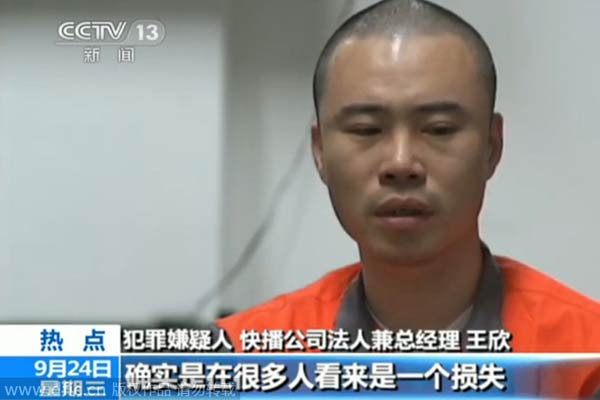Trial of IT executives puts judges to the test
 |
|
This screen shot of a news video taken on Sept 24, 2014 shows Wang Xin, former CEO of QVOD Technology Co Ltd, during an interview at a detention center in Beijing. [Photo/IC] |
The heated discussion both online and in the print media about the trial of four former executives of Shenzhen QVOD Technology Co, an online video service company, which was broadcast live on Thursday and Friday, has exerted pressure on the judges.
But the trial, in which the defendants did a good job of pleading not guilty of the charge of spreading pornographic content with their own software technology, has made this case a very important one in many ways.
As far as procedural justice is concerned, the argument the defendant made warrants further investigation and proper evaluation of the evidence. If the evidence the prosecutors collected is not sound enough or the way it was collected did not follow proper legal procedure, the prosecutors need to do a lot more to prevent the judges from ruling a mistrial.
For the judges, the debate provoked by the broadcasting of the trial has actually exerted a lot of pressure on them. The plausible points the defendant and his lawyers made have tilted public opinion in the defendants' favor, which is evidenced by the majority of the opinions posted online and some opinion pieces published both online and in the print media.
Facing such a situation, it is extremely important for the court and judges to maintain their independence by studying the evidence and the way the evidence was collected in an impartial and careful manner. However persuasive or seemingly convincing some of the opinions raised may be, the court should never be swayed from the principle that the final ruling must be based on the evidence and application of the law.
Given that the defendants are executives of an Internet software technology firm and the technology they invented was once used by a great number of Internet users, this trial will possibly have an impact on the sphere in which such technologies will operate in the future.
The trial also raises the question of how rules should be made in such a way that as small a gray area is left as possible in which new Internet technologies can play hide and seek.
Given that the broadcast has aroused public concerns about the trial, enough caution must be employed in studying the evidence and deciding the application of the law so that a fair and responsible verdict is made.
In other words, the ruling should win the court credibility rather than the other way around.







